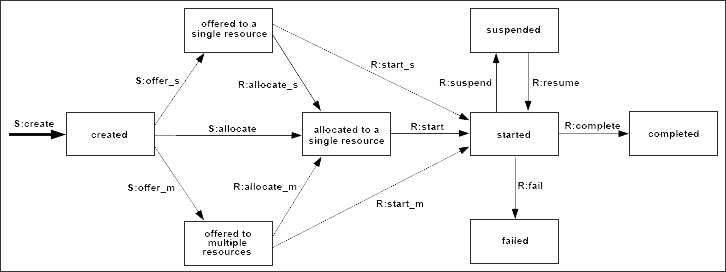Activity allocation patterns
The selection of process participants for activities in the business process can be categorized by activity allocation patterns . A rich set of allocation patterns has just been introduced, in this section, the most appropriate patterns are discussed.

Direct allocation ( Direct Allocation )
in direct allocation, any person beyond a position in an organization, are all examples of activities dedicated to a particular activity model. This resource allocation is useful in cases where there is exactly one person who is suitable for these activities. Like the head of a company, someone who ultimately decides to invest more than a certain threshold.
Direct assignment can always be simply simulated by assigning a role to a member based on the role assignment, which is described in the next heading. If, if this property and asset of the organization remains constant over a long period of time, the introduction of a new role is not necessary, and therefore direct allocation can be used.
Assignment based on roles ( Role-Based Allocation )
Role-based allocation is the standard method of assigning work to members of the organization . This method is based on the understanding of all members of a particular role that have equivalent performance, so that each member of that role can do a unit of work. For each activity model in a business process model , the assigned role indicates that all members of that role are able to perform activity examples. Mapping role information for specific knowledge personnel is called role clarity . Common and current information is used on the ability of knowledge workers during role clarity.
There are two ways to achieve role-based allocation. In the first method When a sample of activity enters standby mode, the work item communicates between group members. When a group member selects a work item, that work item is deleted along with the other group members. In the second method , only one person is selected to perform the activity sample. So, only one work item is created.
Role-based allocation provides a set of interesting advantages over direct allocation, all of which are related to increasing the flexibility of business processes . First, the business process model does not need to change when there is a change in staff, for example, retired employees and new employees are hired. When direct allocation is used, any changes in personnel related to individuals are directly assigned that result in a change in It becomes a business process model .
Second, by the clarity of the role at the time of running the business process , only those present for the activities are selected. This approach avoids situations in which individuals are selected to perform activities that are not currently available. In direct role decision making, there is no way to continue the business process when the person is not available .
Allocation Deferred ( Deferred Allocation )
the allocation of deferred (deferred), the decision about who will do a sample activity only during the execution of business processes it was made. For this purpose, there is no difference between term allocation and role-based allocation. However, the allocation of long-term, rather than using the information defined during design time, assigning as a clear step in the business process is done , and not under the influence of role.
Licensing ( Authorization )
license people to sample activities that the allocation is based on their position. It therefore specifies a list of enumerated situations that specific individuals can perform. This can also be achieved by adding a new licensed role. A specific type of licensing is possible that uses the capabilities of the knowledge worker to perform the allocation. Separation of duties ( Separation of Duties
)
The assignment scheme is the separation of tasks related to different reports within a business process . For example, a document needs to be signed and reciprocated by two employees with a common role. In task-based allocation, these activities can be performed by the same staff. Separation of duties allows each document to be signed by two different employees.
Handling Case ( Case Handling )
in the case of moving the allocation plan, specific activities in the business process requires an understanding of the overall situation there. In this environment, the worker is knowledgeable of all the activities of a business process instance Pays, very useful. This method reduces errors and processing time, because the knowledge worker already knows the cases, and therefore can solve these problems more effectively and is more efficient than one that is not known.
Allocation based on the history of ( History-Based Allocation )
Idea allocation based on history like that, a person for a sample of activities based on what the person has previously worked in the history of activity that he had completed , is assigned. The goal is to assign work to individuals based on their personal experiences and expertise that are not reflected in the information. While this is not part of the role characteristics, this information should be included in the business process management system Be shown so that it can decide on the allocation based on history and personal experience.
Organizational Assignment ( Organizational Allocation )
If the allocation of organizational role is not in the position in the organization generally is used to allocate the activity. For example, a cost authorization is the manager of an organizational unit that approves the need for a cost request.





